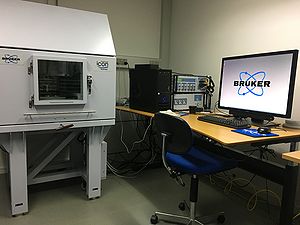Specific Process Knowledge/Characterization/AFM: Atomic Force Microscopy: Difference between revisions
| Line 143: | Line 143: | ||
|style="background:silver; color:black"| | |style="background:silver; color:black"| | ||
|style="background:LightGrey; color:black"|Super Sharp Si Cantilever/tip | |style="background:LightGrey; color:black"|Super Sharp Si Cantilever/tip | ||
|style="background:WhiteSmoke; color:black"|[http://www.nanoandmore.com/AFM-Probe-SSS-NCHR SSS-NCHR] | |||
|style="background:WhiteSmoke; color:black"|[http://www.nanoandmore.com/AFM-Probe-SSS-NCHR SSS-NCHR] | |style="background:WhiteSmoke; color:black"|[http://www.nanoandmore.com/AFM-Probe-SSS-NCHR SSS-NCHR] | ||
|- | |- | ||
Revision as of 09:22, 15 May 2020
Feedback to this page: click here
AFM Icon 1 & 2
DTU Nanolab has two pieces of Bruker AFM Dimension Icon-Pt. AFM stands for Atomic Force Microscope which is a scanning probe microscope where a sharp probe is scanned across a surface either in contact mode, tapping mode or PeakForce tapping mode. The outcome is a topographic plot of the surface. It has a lateral solution of about 1 nm and a vertical resolution of less than 1 Å which makes it very suitable for topographic characterization in the nanometer regime. The limiting factor however is often the size of the probe in use. The tip radius of curvature (ROC) can be from 2 nm up to more than 20 nm depending on the chosen probe. The half cone angle of the tip can vary from less than 3o to over 25o giving problems resolving high aspect ratio structures.
The main purposes are surface roughness measurements and step/structure high measurements in the nanometer and sub-micrometer regime. For larger structure see the topografic measurement page.
To get some product information from the vendor take a look at Bruker's homepage [1]
Before training: Please watch the training videos before the training on the instrument:
AFM Icon Part 1, AFM Icon Part 2 and AFM Icon Part 3
You can find them here: link to training videos
It is also recommanded to read Brukers presentation of contract mode, tapping mode and peak force tappping mode click HERE
The user manual, quality control procedure and results and contact information can be found in LabManager:
AFM Icon 1 in LabManager
AFM Icon 2 in LabManager
Process Information
- For a tutorial on AFM see here: AFM
- Free analysis software: For visualizing and analyzing AFM and Optical profiler files (Nanoman and Sensofar) Gwyddion
- or you can install Brukers own software analyses program that can be found on the cleanroom drive: U:\DCH\CleanroomDrive\_Equipment\AFM\NanoScope_Analysis_x86_v170r1sr2.exe
- or you can get a SPIP license for free if you are connected one of the following institutes (Nanolab, Physics, Chemistry, Mechanics, Energikonvertering) , by contacting John Tandrup Riedel
- Media:AFM_Re-training_2015_v2.pdf
- AFM Icon Acceptance 1 & 2 and overview of accessories and modes on the systems
- What experiment/mode and probe to select
- Bruker introduction to contact mode, tapping mode and peak force tapping mode + how to improve image quality
- KPFM measurements - work function
An overview of the performance of the AFM Icon
| Equipment | AFM Icon | AFM Icon 2 | |
|---|---|---|---|
| Position |
Inside the cleanroom |
In the basement of building 346 room 904 | |
| Purpose | Topografic measurement in the nanometer and and sub-micrometer regime and electrical and mechanical measurements |
|
|
| Performance | Scan range xy | Up to 90 µm square | Up to 90 µm square |
| Scan range z | Up to 13µm | Up to 13µm | |
| Vertical noise floor | <30pm RMS | <30pm RMS | |
| X-Y position noise (closed loop) | <0.15nm RMS | <0.15nm RMS | |
| Z sensor noise level(closed loop) | 35pm RMS | 35pm RMS | |
| Integral nonlinearity(X-Y-Z) | <0.5% | <0.5% | |
| X-Y position noise (closed loop) | <0.15nm RMS | <0.15nm RMS | |
| Max. scan depth as a function of trench width W | ~1 for our standard probe. Can be improved to about 10 with the right probe | ~1 for our standard probe. Can be improved to about 10 with the right probe | |
| Hardware settings | Tip radius of curvature | Standard probe: <12 nm | Standard probe: <12 nm |
| Standard soft tapping mode Cantilever/tip (can be used in both tapping mode and ScanAsyst mode) | Tap150Al-G | Tap150Al-G | |
| Standard ScanAsyst mode Cantilever/tip | ScanAsyst in Air | ScanAsyst in Air | |
| Standard Tapping mode Cantilevers/tips | Tap300Al-G | Tap300Al-G | |
| Super Sharp Si Cantilever/tip | SSS-NCHR | SSS-NCHR | |
| High Aspect Ratio Cantilever/tip | AR5-NCHR | AR5-NCHR | |
| Cantilevers/tips vendor | |||
| Substrates | Substrate size | Up to 210mm in diameter and up to 15mm thick" | Up to 210mm in diameter and up to 15mm thick" |
| Motorized stage (X-Y axis) |
|
| |
| Substrate material allowed | In principle all solid and none-poisonous materials | In principle all solid and none-poisonous materials | |

